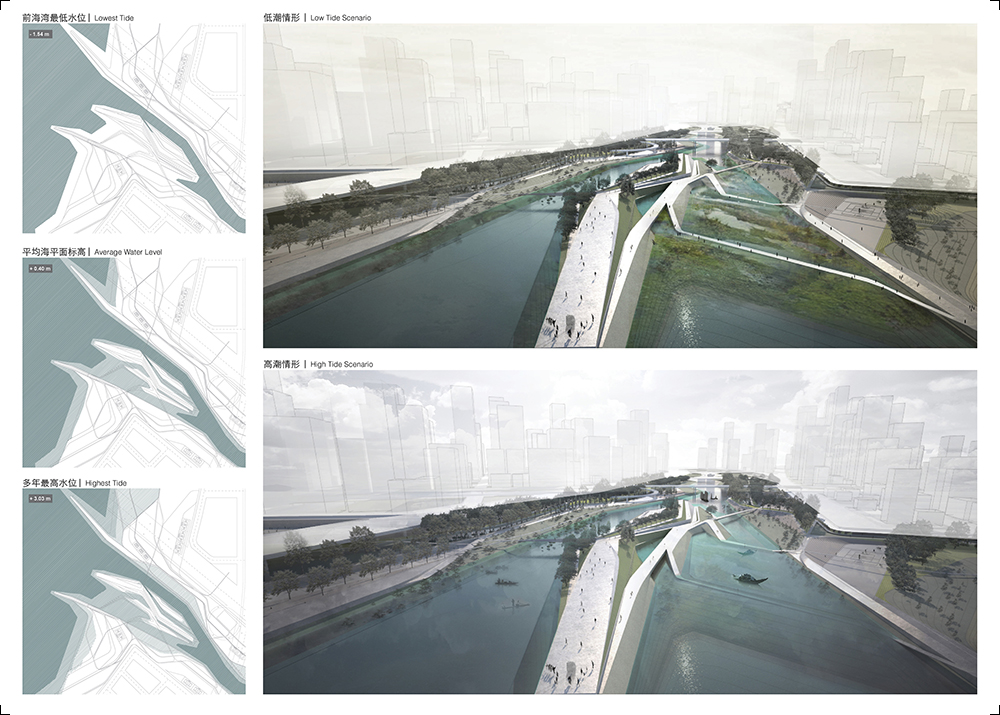fluXtuation
Year: 2014
Size: 100 ha
Type: landscape
Status: competition
Location: Shenzhen, Guangdong, China
Client: Shenzhen Qianhai Group
Partners in charge: Chen Chen, Federico Ruberto, Nicola Saladino
Design team: Yifu Liu

The integrated ecological infrastructure of this project emerges from three layers: the diversification of open spaces / activities, the complex multiplicity of connections, the pockets / landforms / platforms / wetlands biodiversity. The site is wired by a continuous circulation circuit, linking in succession several nodes and generating, through punctual links, a spatial system of interdependent intensities: all the activities are located along the “Loop” – a seamless pedestrian and biking network.
The island is situated in the central intersection, connected with the mainland through three bridges. It’s the nodal attractor of the masterplan, the active-pulsating heart of the project through the articulation of the levels and the diversification of the programs, which are activated and deactivated by the tidal oscillations.
The topography is organized into three main levels: uplands, freshwater wetlands and tidal terraces. Given the existing grade, the southern channel is shallower than the northern one. Different platforms of tidal dynamics are planned to strategically embrace the topography and the circulation, designed to provide unique spatial experiences throughout the various environmental conditions of the landscape. A diversity of plant communities are selected according to the humidity and salinity of different terraces. They range from mangrove, saltwater and (cleansing) freshwater wetlands to upland species.
The geometry of the central area is originated by the presence of the activities that have been integrated into its specific landform. At the island core the visitor could experience a brief introduction to the site history, passing through the main exhibition space; he could navigate and enjoy the diversity of material conditions, walking through multiple facilities: a rock-climbing wall overhanging on the central canal, a running track where to train on different slopes, a sunbathing area, a skate-park shaped by seamless and intricate hills…
The topographical reliefs of the central area are elaborated to revolve around the presence of the historical stone. The waterfront is the moment in which the complex articulation of the topography camouflages with the context. The program, the connections and the landforms disappear virtually to visually concretize on the central platform, the highest point of the masterplan where the stone is rendered as the main protagonist of the scene.
“起伏•连接”创造了这样一个多层整合景观基础设施系统:多样性的开放空间和活动场所,多路径连续一体的慢行网络,与地形紧密结合的生物多样性。他们将城市排洪、雨水管理与市民的游园、戏水、晨练等休闲活动在空间中结合成一个有机的整体,共同提升城市的生态环境和市民的空间质量。
方案以“慢行圈”空间系统为结构,用连续的步行和骑行网络将所有的开放空间和功能场所串联起来,并将地段与其周边的慢行网络无缝的连接起来。不同长度(7分钟,10分钟和30分钟)慢跑圈的路径(坡度及所经过的活动场所)被精心的设计和布局,以提供使用者不同时间对不同休闲功能的多种需求。
前海石景观岛处于这个慢行网络的核心区域,位于多个慢行圈的中央交叉点,也因此是休闲活动最为集中和多样的区域。它与两侧的滨河景观带通过三处步道和一处浮桥联系起来。在多种不同水位的情形下,景观岛的边界呈现不同的形态,为使用者带来丰富的景观体验。
延续总体规划中的“三台阶”形式,方案利用一系列的台地连接城市与水面标高,并根据他们与海平面的高差关系分为高地,淡水湿地和海水湿地。满足防潮防洪排涝的同时通过高低起伏的地形变化营造丰富的空间体验。方案的地形和流线设计充分考虑了对海潮水位一日中时间性、季节性变化的包容,并利用自然的动态性在不同天气、时节、潮汐状况下为使用者提供多样而独特的景观空间体验和与自然互动的机会。
不同功能场所的特殊剖面要求整合设计成为丰富而连续变化的微地形。例如连接不同标高的露天剧场,穿梭在湿地中的抬升步道,攀岩和滑板乐园区域戏剧性的地形变化,不同特征的水岸线等。
景观岛的地形设计尤其如此:在地段制高点9米处标志性的前海石主题广场,升起的地形中嵌入了一个小型的前海石纪念中心,为人们提供对地段历史的介绍;穿过展廊,到达运动中心:一座7米高的岩壁位于水面一侧,成为攀岩爱好者的乐土;滑板公园的人工地形创造出一系列惊险的瞬间;穿梭的跑道上下起伏……这一切构成了一个运动与自然共生的生活场景。









